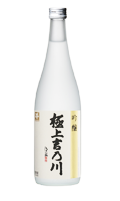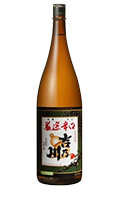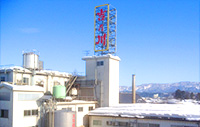- a sake maker with history and tradition.
- Yoshinogawa has a tradition dating back 470 years of
producing the best Sake in the rice-growing heartland of
Niigata province Founded in 1548. Yoshinogawa is the oldest
brewery in the famed Sake producing region of Niigata Japan.
Pick Up SAKE
 GINJO GOKUJO YOSHINOGAWA
All rice used for Yoshinogawa sake is grown in the Niigata prefecture which is known for producing crisp, clean, fragrant, silky smooth sake. Gokujo means ‘excellent’ and it can be used only for the top range of Ginjo style within the brewery. This sake is matured in tank for at least 6 months before bottling and Yoshinogawa bottles this sake every month to ensure its freshness. Ginjo Gokujo shows hints of stone fruits like peach and nectarine. It is lean and tight on palate with soft acidity with a hint of bitterness and some licorise/anise flavours. It has a smooth and silky mouth feel along with some nice subtle complexity.
GINJO GOKUJO YOSHINOGAWA
All rice used for Yoshinogawa sake is grown in the Niigata prefecture which is known for producing crisp, clean, fragrant, silky smooth sake. Gokujo means ‘excellent’ and it can be used only for the top range of Ginjo style within the brewery. This sake is matured in tank for at least 6 months before bottling and Yoshinogawa bottles this sake every month to ensure its freshness. Ginjo Gokujo shows hints of stone fruits like peach and nectarine. It is lean and tight on palate with soft acidity with a hint of bitterness and some licorise/anise flavours. It has a smooth and silky mouth feel along with some nice subtle complexity.1800ml, 720ml, 300ml
 GENSEN KARAKUCHI
Gensen means ‘specially selected’ and Karakuchi means ‘dry’. Yoshinogawa have been producing this particular sake for 30 years. It is what they would describe as their everyday drinking sake. This sake is quite a fruity style of sake, with soft ‘Ginjo-ka’ character, showing hints of strawberry, banana, musk and apple on the nose. The palate is showing tight structure, with hints of citrus, and a savoury aspect, finishing long and dry.
GENSEN KARAKUCHI
Gensen means ‘specially selected’ and Karakuchi means ‘dry’. Yoshinogawa have been producing this particular sake for 30 years. It is what they would describe as their everyday drinking sake. This sake is quite a fruity style of sake, with soft ‘Ginjo-ka’ character, showing hints of strawberry, banana, musk and apple on the nose. The palate is showing tight structure, with hints of citrus, and a savoury aspect, finishing long and dry.1800ml, 720ml, 300ml, 180ml
Water
 Japanese sake is 80 per cent water.
Japanese sake is 80 per cent water.
Underground water from Japan’s largest river, the Shinano, and melted snow water from the Nagaoka Eastern Mountain range mingle together deep below the surface of the earth and gush forth from a well in the brewery grounds. This is the water used to prepare Yoshinogawa sake.
 This underground spring, known as the “TENKA-KANROSEN,” produces a small volume of soft water with a perfect balance of minerals. The vital ingredient in Yoshinogawa’s sake, with its reputation as “clean sake, smooth to the taste,” is water.
This underground spring, known as the “TENKA-KANROSEN,” produces a small volume of soft water with a perfect balance of minerals. The vital ingredient in Yoshinogawa’s sake, with its reputation as “clean sake, smooth to the taste,” is water.
Rice
 Insistence on rice grown in Niigata Prefecture and cultivated by the brewers themselves. Niigata Prefecture is famous throughout Japan as a rice-growing heartland. It is here that the sake rice we use at Yoshinogawa is cultivated
Insistence on rice grown in Niigata Prefecture and cultivated by the brewers themselves. Niigata Prefecture is famous throughout Japan as a rice-growing heartland. It is here that the sake rice we use at Yoshinogawa is cultivated
 The brewers who make the sake are farmers who grow rice in the summer. With their thorough knowledge of the role of rice in sake-brewing, they brew sake using rice known as kurabito saibaimai or brewer’s rice which they themselves have worked hard to grow.
The brewers who make the sake are farmers who grow rice in the summer. With their thorough knowledge of the role of rice in sake-brewing, they brew sake using rice known as kurabito saibaimai or brewer’s rice which they themselves have worked hard to grow.
Skill
 Those who make sake are called “kurabito” or “men of the brewery”. The person with ultimate responsibility is the toji or master brewer. The outskirts of the city of Nagaoka in Niigata Prefecture, with sophisticated sake-brewing technology are also known as the home of master brewers. The sake brewers of Yoshinogawa, inheriting traditional skills going back over 460 years, continue to search for the ideal sake.
Those who make sake are called “kurabito” or “men of the brewery”. The person with ultimate responsibility is the toji or master brewer. The outskirts of the city of Nagaoka in Niigata Prefecture, with sophisticated sake-brewing technology are also known as the home of master brewers. The sake brewers of Yoshinogawa, inheriting traditional skills going back over 460 years, continue to search for the ideal sake.
 Even during the war, and other periods when rice was in short supply, we at Yoshinogawa have made the brewing of Ginjo the basis of our sake production, and preserved technology and tradition handed down from generation to generation.
Even during the war, and other periods when rice was in short supply, we at Yoshinogawa have made the brewing of Ginjo the basis of our sake production, and preserved technology and tradition handed down from generation to generation.
 Originally, Ginjo was sake produced only in small amounts so that the breweries could deepen the secrets of the sake-brewing art. Ginjo sake, which is made by grinding away over 50 per cent of each individual grain, was very luxurious sake which could only be dreamed of by ordinary people.
Originally, Ginjo was sake produced only in small amounts so that the breweries could deepen the secrets of the sake-brewing art. Ginjo sake, which is made by grinding away over 50 per cent of each individual grain, was very luxurious sake which could only be dreamed of by ordinary people.
Climate and Natural Features
 Niigata Prefecture, home to Yoshinokawa’s brewery, is also renowned for its snowfall.
Niigata Prefecture, home to Yoshinokawa’s brewery, is also renowned for its snowfall.
The heavy snow, which contains a lot of moisture, piles up to transform the brewery into a natural refrigerator.
 The fermentation which takes place during the brewing process is closely connected with microbes which wash out dirt and dust in the atmosphere. Snow has a very important role to play in the brewing of sake which dislikes microorganisms and requires low temperature control.
The fermentation which takes place during the brewing process is closely connected with microbes which wash out dirt and dust in the atmosphere. Snow has a very important role to play in the brewing of sake which dislikes microorganisms and requires low temperature control.

